25. Oct 2015 - DOI 10.25626/0116
Dr Marko Zajc is Research Associate at the Institute of Contemporary History in Ljubljana. His scholarly interests include border studies, history of Yugoslavism and history of intellectuals and nationalism in Slovenia and Yugoslavia. He is the leader of the project funded by the Slovenian Research Agency the Phenomenon of Border Rivers (2014-2017). His research has been published in “Südosteuropäische Hefte” and “Études Balkaniques”, among other journals. His book about the construction of the Slovenian-Croatian border in 19th century was published in Slovenian and Croatian language.
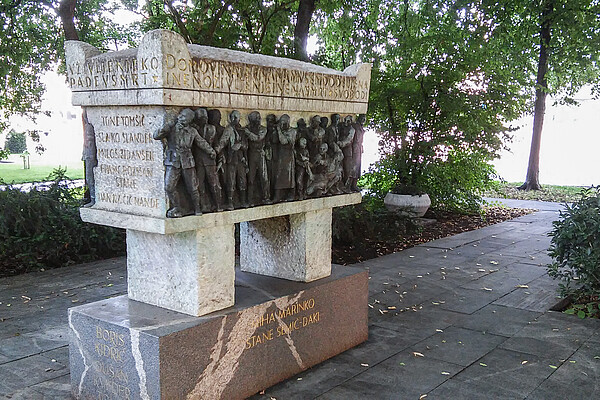
In May 1985, Slovenia – one of the six ‘socialist republics’ of Yugoslavia at the time – celebrated Victory Day and the 40th anniversary of liberation. In May 2015, independent Slovenia celebrated the 70th anniversary of the end of WWII, as if the war were a kind of a natural process that simply ended, as the summer ends. What happened to the victory celebration? Obviously, something has changed in the interim: apart from the fact that Yugoslavia ‘fell to pieces’, self-management socialism failed and Slovenia gained EU-membership. The discursive differences between the two official state celebrations are not just the result of the transition from communism to democracy, or the transition from socialism to capitalism, but they reflect the deep crisis of the official state/national ideology.
After 1991, several things changed for Slovenian nationalism. Slovenian politics was used to being able to identify itself with a geographically larger space than that of Slovenia (if they needed to). After independence, it was of course confronted with a relatively small geographical and 'imaginary' space. The myth of Slovenian exceptionalism was slowly dissolving (Slovenia as 'the west of the east', successful transition to democracy, etc.). The concept of Slovenian national sovereignty did not fulfil the expectations from the 1980s. Božo Repe, Professor of contemporary history at the University of Ljubljana, claims that, 'Slovenia today has less sovereignty than it had in the federal Yugoslavia.[1] Whatever the truth, Slovenian contemporary leaders have no ambitions to lead a sovereign national policy. In the context of globalization and the European Union, the space for practicing Slovenian state sovereignty is indeed narrow. Most of the important decision-making is left to EU institutions or to the 'invisible hand' of the market. One of the rare areas where the Slovenian political elite endeavours to govern independently is with regard to identity and memory politics.
There are numerous debates about WWII and its consequences in the contemporary Slovenian public sphere. Journalists and media commentators often discuss the issues of fascism/Nazism, resistance to fascism/Nazism, revolution, collaboration, massacres, violence and suffering. Professional historians quarrel over the interpretation of the events during WWII and the implications for Slovenian contemporary society. Amateur historians are trying to uncover the past in order to support a black and white perception of the world. Exhibitions in museums focus on the suffering of individuals. Leftist activists are rebuilding old partisan memorials; rightist activists are erecting new monuments of the anti-communist reaction. In order to structure such a large quantity of material, this article will begin with an overview of the use of the notions 'national disunity' and 'national reconciliation'. Afterwards, the focus will be on the two official celebrations: in 1985, the 40th anniversary of liberation, and in 2015, the 70th anniversary of the end of WWII. I will analyse the idea of 'moderate' reconciliation in the case of the Memorial of Reconciliation whose construction started in June 2015. Different perspectives of the political groups will be presented through the analysis of the viewpoints of two ideologically and structurally different political groups: The Slovenian Democratic Party and The United Left Coalition. I will try to explain the peculiarities of Slovenian history along the way, insomuch as it is needed to understand the contemporary debates.
The notion of national reconciliation could already be found in nineteenth century Slovenian press, although the term 'national unity' (narodna sloga) was still widely in use. Similarly, as with other Central European small nations, the split between the liberal and the catholic-conservative sides decisively marked the Slovenian political scene of the late nineteenth and early twentieth centuries. The dichotomy between clericals and liberals thus became the basic discursive framework through which Slovenian politics perceived itself.[2]
After the Axis attack on Yugoslavia in April 1941, Yugoslav Slovenia was divided between Germany, Italy and Hungary. Together with the liberal left and Christian social groups, the Slovenian communists established the Liberation Front, which organised the resistance against the occupiers. The Slovenian Partisans were undoubtedly successful. But they didn’t just win the fight; in fact, they mobilized huge support for their cause, and for the most part, they liberated Slovenia themselves. And perhaps most importantly, they established a Slovenian federal unit as part of the new Federal Yugoslavia with new borders and re-established national institutions. In this regard, they had managed to realize an old Slovenian political dream from the year 1848 – the Zedinjena Slovenija (United Slovenia).[3]
But there is also a dark side to all of this that is inseparable from the notions of disunity and reconciliation. While the Partisans fought successfully against the occupiers, the conservative political forces, afraid of communism, collaborated with the occupiers and established anti-communist militias. In 1943, the Home Guard (Domobranci) units were organised under the patronage of the Wehrmacht. Members of the Home Guard entities actively participated in fascist atrocities (executions, deportations to concentration camps, torture).[4] The new communist leaders of Slovenia, who were convinced they were not just the 'avant-garde of the proletariat' but also the 'avant-garde of the Slovenians – the nation of proletarians', tried to secure victory by all possible means. Right after the war, more than ten thousand Slovenian quisling troops were massacred, most of whom were returned to Slovenia by the British Army from Austrian Carinthia. Furthermore, members of various quisling entities from other parts of Yugoslavia, who tried to reach western allies in the last days of WWII, were captured on Slovenian soil; most of whom were massacred in Slovenia as well.[5] Since 1997, the Institute of Contemporary History has been systematically researching the death toll in the territory of the Republic of Slovenia during WWII and immediately afterwards. In total, 99 805 people with permanent residence in Slovenia died in what is today’s contemporary Slovenia (that’s more than six per cent of the population). On the other hand, Partisan units suffered 28 660 casualties, and we can identify 15 364 deaths from various anti-partisan units – the majority of which were killed in post-war massacres.[6]
The nationalist opposition intellectuals used the concept of nation-reconciliation in the 1980s in order to present the relatively liberal Yugoslav socialist system as totalitarian and anti-Slovenian. They opened-up the taboo issue of the post-war massacres and appealed for national reconciliation. When Spomenka Hribar opened the debate on reconciliation in 1984 with her essay "Guilt and Sin" (Krivda in greh), she did not want to emphasise the discourse of the divide between left and right. She argued that Slovenians would live in peace only when both sides would reconcile. The left must admit to the massacres, the revolution and their undemocratic system, while the right must recognize the war crimes and their collaboration with the fascists. Without this, the latent civil war would continue, and at some point, escalate.[7] The image of the Slovenian nation as a subject of history, a homogenous entity which must deal with its past as some kind of a collective individual, is certainly intellectual but nevertheless, narrow and simplistic.[8] Since most of the younger and mid-generation Slovenians (socialized in a socialist Yugoslavia and keen on globalization) did not feel the need to reconcile because of WWII, 'disunity' and 'reconciliation' were soon adopted by the conservative-right as their main discourse.[9]
Meanwhile, some independent journalists and public commentators happily embraced the notion of disunity. It gave them the opportunity to interpret complex political issues in a simple and understandable fashion. Although almost all of them criticized the notion, they also constructed it. Certain politicians and parties identified themselves with the partisan side while others identified with the anti-partisan side; and, accordingly, the commentators followed suit. Publicists of various convictions and orientations saw this dichotomy as a typical Slovenian characteristic. From this, an impression was made: Slovenian society, with regard to history, is somehow split into two blocks of the same size. But this was just an impression. According to the Slovenian Public Opinion Survey (in 1995, and again in 2012), most Slovenians positively regarded the Slovenian Partisan’s fight in WWII as a fight for the Slovenian nation (73.8 per cent / 72.5 per cent). At the same time, only 31.4 per cent in 1995 and 21.2 per cent in 2012 considered the anti-partisan side as a fight for the interests of Slovenians.[10]
In 1985, the Yugoslav political system underwent serious troubles. After Tito’s death the ‘economy of cooperation’ collapsed. Already in 1982, Yugoslavia was unable to pay off its foreign debt, the standard of living was in decline, there were shortages in the shops, and major electricity cuts. The peculiar political system was also in crisis. In the mid-eighties, constitutional debates were at their peak: re-establish state socialism or introduce ‘bourgeois democracy’? Confederation or re-centralisation of Yugoslavia?[11] In this political climate, the Socialist Republic of Slovenia was celebrating the 40th anniversary of liberation. The festivities were held in the small Village Poljana, which was the scene of the ‘last fights between the Slovenian Partisans and the enemy’ on 15 May 1945, a week after the official end of the war in Europe. The solemn speaker was Stane Dolanc (1925–1999), a member of the ‘partisan generation’ and one of the most successful Slovenian politicians at the Yugoslav level. Although he praised the heroism of the Yugoslav Partisans and their role in the anti-fascist struggle, he could not avoid the ‘economic and other problems in … society’. The opposition to the regime was mentioned indirectly. Dolanc criticized the use of the term ‘national reconciliation’, which was popular with the Slovenian intellectual opposition. ‘We will never agree to a reconciliation between revolution and contra revolution. … Is it really appropriate to equate those who fought for freedom with those who served the occupiers?’ He admitted there were some ‘individual tragic events’ during the liberation war, but, he said, this does not prove the ‘inhumanity of our revolution.’[12] The commentators in the newspapers followed along these lines. The ‘anniversary-discourse’ of Victory Day in 1985 was marked by the language of crisis – yet, there was enough room for optimism.[13]
The politics of national reconciliation, which was seen by Slovenian socialist leaders in 1985 as a dangerous and destructive concept, by 2015 became the official memory politics of the Slovenian state. Curiously enough, current Slovenian leaders try to promote the concept of reconciliation without using the actual word. As already stated, after 1991 the term reconciliation became a euphemism for fierce anti-communism and revisionism. The current political establishment is trying to construct a new, more moderate, concept of national reconciliation. The basic ideological premise of the leading Slovenian political party (the Modern Centre Party; formerly, the Party of Miro Cerar) is in fact, moderation. The leader of the party, and Slovenian Prime Minister, Miro Cerar frequently emphasises, ‘we should close the wounds of the past in order to become the society of tolerance and reconciliation.’[14] Cerar, who established ‘his’ party just a couple of months before the extraordinary elections in 2014, gained a reputation as a professor of constitutional law and defender of morality and rule of law.
The creators of the official celebration of the 70th anniversary of the end of WWII had a difficult task: how should they celebrate the anniversary and at the same time retain the right balance between different conceptions of the celebrated date? How should they credit Partisan liberation without hurting the feelings of those who consider the Partisans to be the ‘bad guys’? What should they do? They chose to avoid the controversial contents, and instead to internationalize/globalize the show, and above all, they provided a lot of good music. To put it simply, instead of celebrating with clear ideological implications, they produced a great cabaret show.
Usually, on such occasions, Slovenian Partisan songs are sung, which are known for their fighting spirit and emancipatory charge. Naturally, the authors of the show could not avoid Slovenian Partisan songs, but they chose to perform only one: Our Homeland is Free, a relatively mild song about freedom and the homeland. Nevertheless, they left out the strophe that does not fit with the politics of reconciliation. This song was balanced with the next song on the program: the big band jazz classic, In the Mood. True, the cultural program included other Partisan songs, but not Slovenian ones. Artists performed French, Italian, and Russian Partisan songs, and even a Yugoslav one called, The Grey Hawk (which could actually be defined as the most popular Partisan song in Yugoslavia: The grey hawk, my old friend, give me wings, I would like to fly over the mountains). The latter even includes the lines: comrade Tito, we swear to you, we will win! Organizers did their best to include songs that are not directly linked to the anti-fascist struggle, but which reflect the ‘mood’ of the time. For example: Ich bin von Kopf bis Fuß auf Liebe eingestellt by Marlene Dietrich, and We'll Meet Again by Dame Vera Lynn.[15] The globalization of the performed music placed the anniversary in an international context. Yet, the role of Slovenian Partisans was somehow put in the shade. The performed music gave the impression that Slovenia was liberated by ally forces, not by the Slovenian Partisans themselves.
The keynote speaker was the president of the Slovenian Parliament Milan Brglez (Modern Centre Party). Brglez tried to praise the Slovenian resistance without mentioning the Partisans. The revolutionary dimension of the Partisan struggle was also not mentioned. However, some attention was given to the post-war massacres: ‘As if our nation did not suffer enough under the occupiers – we have inflicted a wound on ourselves with the post-war massacres.’ Although Brglez praised the fighters for freedom and liberation, he never used the term ‘victory’. If he were to specify the winners of the war, he would need to define the losers too.[16]
A previous government labelled as left, also supported the politics of moderate reconciliation. In 2013, the government decided to support a project entitled, Monument to the Victims of all Wars. The site was established as a symbolic representation of ‘making peace with our past’. It was planned that the work should begin with the 70th anniversary of the end of WWII. The southern part of Congress Square in Ljubljana, which was closed to the public until recently, was chosen for the location of the new memorial. In the open call for a public competition, it was specified that the monument would commemorate a "great number of inhabitants of the Slovenian territory, who died as soldiers of various armies in all wars, especially in WWI and WWII. It will be dedicated to numerous civil victims of war and revolution as well."[17] Obviously, we are dealing with a very general monument: the historical period for the commemoration is not specified, and the commemorated groups are also not defined. The only solid ideological 'backbone' of the monument is Slovenian national unity. Furthermore, revolution is defined as a negative phenomenon – one that is equated with war.
The winning project (Architectural Office, Medprostor) foresees two different concrete pillars of the same height. The architectural composition should represent "unity in duality, a dialogue of two equivalent, but different structures, which suppose to represent a basis for reconciliation and the chance for the creation of unified history."[18] National unity will be embodied in the structure itself: for the concrete, only the sand and stones from Slovenian rivers will be used.[19] The so-called "spirit of reconciliation" is especially evident from the encryption. The authors chose a quote from a poem, written by Oton Župančič (1878–1949), one of Slovenia’s most praised poets:
Homeland is one
Given to all
And one is life
And one is death[20]
If we neglect the fact that the poem presupposes a nationalist perception of social reality (the rule: one person can have only one homeland), the above quoted lines seem to be perfect for moderate reconciliation: all we have in common is life, death and homeland. But the verse is hardly appropriate. First of all, they are already carved in an existing monument. Oton Župančič, who supported the Partisan cause, wrote the poem for the Tomb of National Heroes, which was erected in 1949.[21] This memorial is located beside the Slovenian Parliament and is only roughly 400 metres away from the location of the new memorial. The tomb is hidden behind trees and a decorative bush. Secondly, Župančič wrote another two stanzas of the poem:
Committed to freedom
We have gathered to fight
And what is life
And what is death
Future is faith
Who dies for it
Rises to life
When he falls to death[22]
Apart from the fact that the chosen verses are committed to Partisan heroes, together with the other two stanzas, they express a completely different message: it is worth it to die for a better future. Those who have perished in the fighting have not died in vain. It is well known to the Slovenian general public that the encryption has already been used for another memorial. The newspaper Dnevnik published an open letter, written by Vlado Sruk, a retired professor of philosophy, who emphasized that the poem carries ‘a clearly defined message’ and that Župančič’s verses should not be taken out of context.[23]
The fiercest opponent of the Partisan side in Slovenian political life is the Slovenian Democratic Party, currently the biggest opposition party in Parliament. According to the latest public opinion polls in 2015, the Party enjoys 12 to 16 per cent support of the electorate.[24] They build their support on three ideological bases: first, the personality-cult of their leader, Janez Janša; second, post-socialist resentment and anti-communism; and third, a nationalist-conservative historical narrative. The Party uses the term ‘national reconciliation’ as a tool for a rehabilitation of the anti-partisan side in WWII. According to them, the real reconciliation should include acknowledgement that the ex-communists are responsible for the fratricidal war and the post-war massacres. Simultaneously, they are trying to reduce the importance of the collaboration between the anti-communist militias and the occupiers of Slovenia (Nazi Germany, fascist Italy). It is not surprising that the Slovenian Democratic Party does not support the reconciliatory efforts of the current government. The new reconciliation memorial is interpreted as a memorial of Slovenian disunity: "It is clear the memorial with two divided pillars, which are not contiguous, does not symbolise the desire to reconcile. Its intention is permanent preservation of divides. The pillars represent a once unified nation, which was divided due to the communist revolution."[25]
Another group which problematises the elite and political power relations, but in a completely different context, is the United Left Coalition. In 2009–2011, the Slovenian economy collapsed, national debt rose dramatically, and austerity measures were introduced; all of which were accompanied by the longest period of political instability since independence. The Slovenian model of a graduate transition with a high percentage of state ownership was shattered. The austerity measures, imposed by the Janez Janša government, triggered mass protests against the political elite (late 2011 – early 2012). Protesters were using Partisan symbols, paroles and songs in order to place the contemporary 'uprising' in the context of Slovenian history. Political space opened up for a new left party. The United Left, a coalition of leftist parties (Initiative for Democratic Socialism, Democratic Labour Party, Party for Sustainable Development of Slovenia: TRS), which was inspired by the Syriza coalition in Greece, entered Parliament in 2014.
The United Left politicians intentionally try to connect their agenda with the tradition of the Partisan fight. Luka Mesec, the leader of the Initiative for Democratic Socialism, became a regular guest at Partisan celebrations. On 8 May, he delivered a speech on the occasion of the 70th anniversary of the end of WWII on Sabotin hill near the Italian border. In his speech, Mesec argued for a social emancipatory dimension of the Partisan struggle. He tried to contextualise the Partisan fight within the framework of a global anti-fascist and anti-capitalist struggle. The social-revolutionary dimension of the Partisan fight is, according to Mesec, the most important part of the Partisan movement. The European social welfare state would not be possible without the WWII liberation movements. And today? The social welfare state is dissolving, the capital plunders the state, and new fascism is on the rise.[26]
The United Left Coalition is the only political group in Slovenian Parliament that openly rejects the concept of national reconciliation. The leaders of the Initiative for Democratic Socialism, most of them young social scientists, have clearly defined the importance of reconciliation for Slovenian politics: "Already at the end of the 80s the political class proclaimed national reconciliation as one of the most important projects of the new Slovenia."[27] On the inside, the concept became the "new ideology of the political class"; on the outside, it created new political divides, which enabled an easy political mobilisation. According to the Initiative, national reconciliation paves the way for the rehabilitation of fascism.[28]
The memory politics of moderate national reconciliation, supported by the political centre, has its limits. Although the current establishment tries to avoid expressing any views regarding WWII, they present a very narrow version of Slovenian history that does not differ much from the perception of the political right: the history of WWII in Slovenia is perceived as a conflict of two more or less equal sides. The two pillars of the reconciliation memorial are planned for a reason. Slovenian terms razklanost and razcepljenost (disunity and division), which are frequently used, denote the split of one unit into two parts. This dualism of historical perception prevents the creation of a more plural and complex outlook on the past in the public sphere. The emphasis on national unity is even more problematic: the only bond that connects various victims is supposed to be Slovenian national identity. Pre-national, provincial, local and hybrid identities are not considered.
Achieving equilibrium between the two sides of WWII is not possible because they had a different role in the war, and they are structurally incomparable. The politics of national reconciliation has another problem on the level of the ideology of 'statehood'. Whatever the different interpretations of the Partisan fight, Slovenia as a state (a political unit with established national borders) arose from the Partisan struggle. It is not possible to dissect the past and take out only the likable content. If the political centre (moderately) and the political right (openly) leave the Partisans out of the Slovenian historical narrative, they weaken the ideological basis of Slovenian sovereignty. The Right and the Centre are facing this issue differently. The Right denies any Partisan contribution and tries to invent an alternative historical narrative. The Centre only embraces 'the good stuff' (liberation, the establishment of the Slovenian state, a new border in the west, etc.) and conceals the unlikeable parts of the 'liberation war'. The social emancipatory dimension of the Partisan past is as much a problem for the Centre as it is for the Right. The revolutionary emancipatory aspect of the Partisan discourse is seen as a dangerous legacy of the past. While the Right paints the Partisan revolution in the darkest colours, the Centre simply avoids talking about it. Since the crisis in 2009, the level of poverty in the country is increasing – the most distinguishable differences in Slovenian society are indeed of a social nature. In 2013, 14.5 per cent of Slovenians lived below the poverty line. In comparison with the previous year, the poverty rate increased by one percentage point.[29] Since the Right and the Centre have both embraced the neoliberal politics of austerity, they have been trying to defend the status quo in society through the terms of reconciliation. In opposition to them, the new Left stresses a revolutionary character of the Partisan struggle and seeks inspiration for the social struggles of the future. Yet, they tend to neglect the nationalist aspects of the Partisan struggle and they are certainly not immune to producing anachronisms, stereotypes, and glorifying the Partisans in general.
Marko Zajc: The 70th Anniversary of the End of WWII in Slovenia. In: Cultures of History Forum (25.10.2015), DOI: 10.25626/0046.
Copyright (c) 2015 by Imre Kertész Kolleg, all rights reserved. This work may be copied and redistributed for non-commercial, educational purposes, if permission is granted by the copyright holders. For permission please contact the editors.
The celebration of the 70th anniversary of the end of the WWII, full video, May 8 2015
The Victims of all Wars Memorial Competition Project
Janez Janša: The Myth about the National Liberation War, Seventy Years of Lies (The views of Janez Janša, the leader of the Slovenian Democratic Party, on the end of WWII)
Luka Mesec: The Victory day should not be the day of Pyrrhic victory (The solemn speech of Luka Mesec, the leader of the United Left Coalition, on the occasion of May 8 2015)
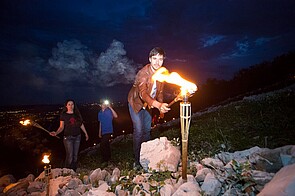
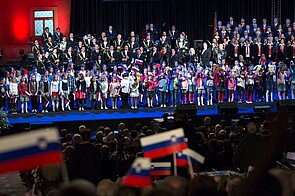
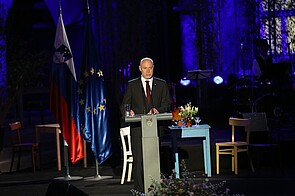

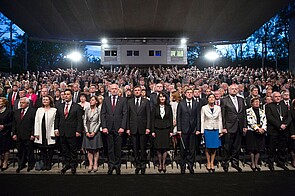
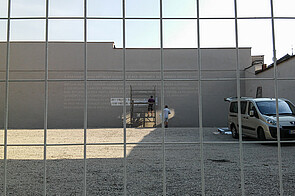
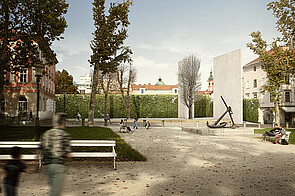
Get this article as PDF download (including pictures).